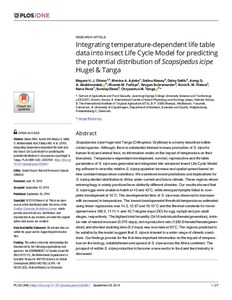| dc.contributor.author | Otieno, M.H.J. |
| dc.contributor.author | Ayieko, M.A. |
| dc.contributor.author | Niassy, S. |
| dc.contributor.author | Salifu, D. |
| dc.contributor.author | Abdelmutalab, A.G.A. |
| dc.contributor.author | Fathiya, K.M. |
| dc.contributor.author | Subramanian, S. |
| dc.contributor.author | Fiaboe, K.K.M. |
| dc.contributor.author | Roos, N. |
| dc.contributor.author | Ekesi, S. |
| dc.contributor.author | Tanga, C.M. |
| dc.date.accessioned | 2019-12-04T11:36:55Z |
| dc.date.available | 2019-12-04T11:36:55Z |
| dc.date.issued | 2019 |
| dc.identifier.citation | Otieno, M.H.J., Ayieko, M.A., Niassy, S., Salifu, D., Abdelmutalab, A.G.A., Fathiya, K.M., ... & Tanga, C.M. (2019). Integrating temperature-dependent life table data into Insect Life Cycle Model for predicting the potential distribution of Scapsipedus icipe Hugel & Tanga. PLoS ONE, 14(9), 1-27. |
| dc.identifier.issn | 1932-6203 |
| dc.identifier.uri | https://hdl.handle.net/20.500.12478/6383 |
| dc.description | Open Access Journal; Published online: 25 Sept 2019 |
| dc.description.abstract | Scapsipedus icipe Hugel and Tanga (Orthoptera: Gryllidae) is a newly described edible cricket species. Although, there is substantial interest in mass production of S. icipe for human food and animal feed, no information exists on the impact of temperature on their bionomics. Temperature-dependent development, survival, reproductive and life table parameters of S. icipe was generated and integrated into advanced Insect Life Cycle Modeling software to describe relative S. icipe population increase and spatial spread based on nine constant temperature conditions. We examined model predictions and implications for
S. icipe potential distribution in Africa under current and future climate. These regions where entomophagy is widely practiced have distinctly different climates. Our results showed that S. icipe eggs were unable to hatch at 10 and 40˚C, while emerged nymphs failed to complete development at 15˚C. The developmental time of S. icipe was observed to decrease with increased in temperature. The lowest developmental threshold temperatures estimated using linear regressions was 14.3, 12.67 and 19.12˚C and the thermal constants for development were 185.2, 1111.1- and 40.7-degree days (DD) for egg, nymph and pre-adult stages, respectively. The highest total fecundity (3416 individuals/female/generation), intrinsic rate of natural increase (0.075 days), net reproductive rate (1330.8 female/female/generation) and shortest doubling time (9.2 days) was recorded at 30˚C. The regions predicted to be suitable by the model suggest that S. icipe is tolerant to a wider range of climatic conditions. Our findings provide for the first-time important information on the impact of temperature on the biology, establishment and spread of S. icipe across the Africa continent. The prospect of edible S. icipe production to become a new sector in food and feed industry is discussed. |
| dc.description.sponsorship | The GREENiNSECT of Danida |
| dc.description.sponsorship | Netherlands Organisation for Scientific Research |
| dc.description.sponsorship | Federal Ministry for Economic Cooperation and Development, Germany |
| dc.description.sponsorship | Canadian International Development Research Centre |
| dc.description.sponsorship | Australian Centre for International Agricultural Research |
| dc.description.sponsorship | BioInnovate Africa Programme Phase II |
| dc.description.sponsorship | UK Aid |
| dc.description.sponsorship | Swedish International Development Cooperation Agency |
| dc.description.sponsorship | Swiss Agency for Development and Cooperation |
| dc.description.sponsorship | The Kenyan Government |
| dc.format.extent | 1-27 |
| dc.language.iso | en |
| dc.rights | CC-BY-4.0 |
| dc.subject | Pest Insects |
| dc.subject | Orthoptera |
| dc.subject | Production |
| dc.subject | Food Security |
| dc.subject | Climate Change |
| dc.title | Integrating temperature-dependent life table data into Insect Life Cycle Model for predicting the potential distribution of Scapsipedus icipe Hugel & Tanga |
| dc.type | Journal Article |
| dc.description.version | Peer Review |
| cg.contributor.affiliation | Jaramogi Oginga Odinga University Science and Technology |
| cg.contributor.affiliation | International Centre of Insect Physiology and Ecology |
| cg.contributor.affiliation | International Institute of Tropical Agriculture |
| cg.contributor.affiliation | University of Copenhagen |
| cg.coverage.region | Africa |
| cg.coverage.region | East Africa |
| cg.coverage.country | Kenya |
| cg.isijournal | ISI Journal |
| cg.authorship.types | CGIAR and developing country institute |
| cg.iitasubject | Climate Change |
| cg.iitasubject | Food Security |
| cg.iitasubject | Pests Of Plants |
| cg.journal | PLOS ONE |
| cg.howpublished | Formally Published |
| cg.accessibilitystatus | Open Access |
| local.dspaceid | 108104 |
| cg.targetaudience | Scientists |
| cg.identifier.doi | https://dx.doi.org/10.1371/journal.pone.0222941 |

